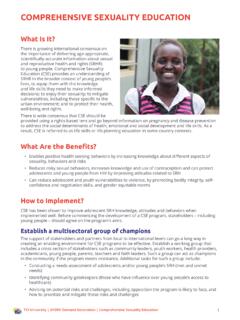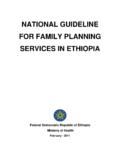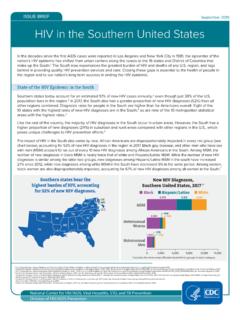Transcription of NATIONAL ADOLESCENT HEALTH AND DEVELOPMENT …
1 MINISTRY OF HEALTH , COMMUNITY DEVELOPMENT , GENDER, ELDERLY AND CHILDREN. NATIONAL ADOLESCENT HEALTH AND DEVELOPMENT . strategy 2018 - 2022. REPRODUCTIVE AND CHILD HEALTH SECTION. DAR ES SALAAMA pril,2018. Page | 0. TABLE OF CONTENTS. LIST OF ACRONYMS .. 3. LIST OF FIGURES .. 5. EXECUTIVE 6. Context .. 6. Situation Analysis .. 6. Strategic Priorities .. 10. Implementation .. 11. BACKGROUND .. 12. Overview .. 12. Rationale For The strategy .. 13. Definition of Key Terms and 14. Methodology .. 16. PHASE I .. 16. PHASE II .. 17. SITUATION ANALYSIS .. 17. ADHD 18. Demand .. 24. Supply .. 28. Enablers .. 34. Policies, Legislations and Commitments .. 34. Financing .. 42. Data and Access to Information .. 44. Coordination .. 47. EFFORTS IN IMPROVING ADOLESCENT HEALTH .. 50. STRATEGIC PRIORITIES FOR 52. Strenghening Communities and Empowering Adolescents Through Demand Side Interventions .. 54. System Strengthening for Supply Side Interventions.
2 55. Improving Enablers of ADHD .. 56. Policies, Legislations and Commitments .. 56. Financing .. 58. Page | 1. Data and Access to Information .. 59. Coordination .. 61. Contributions of the Strategic Priorities to The 63. ACTION PLAN 65. Monitoring and Evaluation .. 66. Page | 2. LIST OF ACRONYMS. AAT Automobile Association of Tanzania ADDO Accredited Drug Dispensing Outlets ADHD ADOLESCENT HEALTH and DEVELOPMENT ADH ADOLESCENT HEALTH AFHS ADOLESCENT Friendly HEALTH Services AIDS Acquired Immune Deficiency Syndrome ARHWG ADOLESCENT Reproductive HEALTH Working Group ART Antiretroviral therapy ARV Antiretroviral ASDP Agriculture Sector DEVELOPMENT Programme AYAS Adolescents and Young Adult Stakeholders Group BCC Behavioural Change Communication BRN Big Results Now CBO Community-based organisation CHF Community HEALTH Fund CSE Comprehensive Sexuality Education CPD Continuing Professional DEVELOPMENT CME Continuing Medical Education CTC II Care and Treatment Clinic II.
3 DHIS2 Demographic HEALTH Information Service 2. DHS Demographic and HEALTH Survey DRC Democratic Republic of the Congo ECD Early Childhood DEVELOPMENT EMIS Education Management Information System EGPAF Elizabeth Glaser Pediatric AIDS Foundation ESA Eastern and Southern Africa FBO Faith-based Organisation GBV Gender-based Violence GoT Government of Tanzania HEADSS Home, Education and employment, Activities, Drugs, Sexuality and Suicide / depression HFS HEALTH Financing strategy HIV Human Immunodeficiency Virus HMIS HEALTH Management Information System HPV Human Papillomavirus HSS HEALTH Systems Strengthening HSSP HEALTH Sector Strategic Plan HTC HIV Testing and Counselling IEC Information, Education, and Communication LGA Local Government Authority M&E Monitoring and Evaluation MKUKUTA Swahili abbreviation for the NATIONAL strategy for Growth and Reduction of Poverty MoEST Ministry of Education, Science and Technology Page | 3. MoFP Ministry of Finance and Planning MoHA Ministry of Home Affairs MoHCDGEC Ministry of HEALTH , Community DEVELOPMENT , Gender, Elderly and Children MoLEYD Ministry of Labour, Employment & Youth DEVELOPMENT MR4H Mobile for Reproductive HEALTH NACP NATIONAL AIDS Control Programme NCD Non-Communicable Disease NGO Non-Governmental Organization NGSRP NATIONAL strategy for Growth and Reduction of Poverty NHIF NATIONAL HEALTH Insurance Fund NPA-VAWC NATIONAL Plan of Action to end Violence against Women and Children in Tanzania OOP Out-of-Pocket OP/IP Outpatient-inpatient PEPFAR President's Emergency Plan for AIDS Relief PLHA People living with HIV/AIDS.
4 PMO Prime Minister's Office PMTCT Prevention of Mother-to-Child Transmission PO-PSM President's office, Public Service Management PO-RALG President's Office, Regional Administration and Local Government PPP Public Private Partnership PSI Population Services International RAIS Road Accident Information System RCHS Reproductive and Child HEALTH Section RH Reproductive HEALTH RMNCAH Reproductive, Maternal, Newborn, Child and ADOLESCENT HEALTH SADC Southern Africa DEVELOPMENT Community SNHI Single NATIONAL HEALTH Insurance SRH Sexual and Reproductive HEALTH STI Sexually Transmitted Infection TACAIDS Tanzania Commission for AIDS. TASAF Tanzania Social Action Fund TC SWAp Technical Committee on Sector Wide Approaches TECC Tanzania Entrepreneurship Competitiveness Centre TZ Tanzania TIKA TibakwaKadi . UMASITA Swahili abbreviation for Tanzania Informal Sector Community HEALTH Fund UNFPA United Nations Population Fund VAC Violence Against Children VIBINDO Swahili abbreviation for association of small industries and small business owners WHO World HEALTH Organization Page | 4.
5 LIST OF FIGURES. Figure 1: Key components of the strategy methodology ..16. Figure 2: Framework for assessing the ADHD situation in Tanzania ..18. Figure 3: Issues that adolescents are at risk for ..19. Figure 4: Changes in HEALTH risk factors for 10-14 year Figure 5: Changes in HEALTH risk factors for 15-19 year Figure 6: Impact pathway of socio-cultural and economic factors on ADHD outcomes ..24. Figure 7: Impact pathway of service delivery, human resources and supply chain on ADHD outcomes ..30. Figure 8: ADOLESCENT HEALTH coordination mechanisms in Tanzania ..48. Figure 9: Proposed sequencing for priorities ..53. Figure 10: Proposed coordination structure for ADOLESCENT HEALTH in Tanzania ..61. Page | 5. EXECUTIVE SUMMARY. CONTEXT. The NATIONAL ADOLESCENT HEALTH and DEVELOPMENT (ADHD) strategy marks the first step of an expanded and holistic focus by the MoHCDGEC on the issues affecting adolescents in the country. Acknowledging the effect of socio-economic and cultural conditions on HEALTH outcomes, there is a shared understanding amongst stakeholders that focusing onholistic DEVELOPMENT outcomes for adolescents is critical.
6 Furthermore, as part of its NATIONAL agenda, Tanzania aims to be a middle-income country by 2025 through industrialisation; given that youth account for the population ( of total population are adolescents), this agenda will be primarily driven by Among other investments, Tanzania therefore needs to pursue positive DEVELOPMENT and HEALTH outcomes for its ADOLESCENT population in order to ensure the demographic dividend is successfully leveraged. The strategy builds on the foundation of the previous NATIONAL ADOLESCENT Reproductive HEALTH Strategies and other relevant policy documents. The first strategy (2004-2008) focused on extending the reach of ADOLESCENT friendly HEALTH services and the second strategy (2011-2015) focused on sexual and reproductive HEALTH of adolescents. This strategy also draws on key policy documents such as the NATIONAL HEALTH Policy 2018 (in draft), the HEALTH Sector Strategic Plan (HSSP) 2015 2020, and the One Plan II which recognize adolescents and call out the need to address ADOLESCENT HEALTH in the country.
7 This strategy (2018-2022) aims to build on these efforts, through a comprehensive approach that equally addresses the demand and supply side, as well as critical enablers for ADOLESCENT HEALTH . In addition, this strategy also aims to ensure that there is continuous, active and meaningful engagement of adolescents. Thus, the strategy involves a broader range of stakeholders who play a part in ADHD. As a signatory to the global Sustainable DEVELOPMENT Goals, better ADHD will directly and indirectly contribute to Tanzania achieving severalof the internationally agreed ADHD strategy provides an opportunity for the country to gain some mileage in implementing the SDGs as the various components of the strategy is linked to six out of seventeen SDGs as shown in the figure below. Consequently, any success in implementing this strategy will improve the HEALTH and holistic DEVELOPMENT of adolescents, yield NATIONAL gains for Tanzania and improve its positioning within the international DEVELOPMENT ecosystem.
8 SITUATION ANALYSIS. In this strategy , the state of ADHDhas been assessed from three lenses of demand, supply and demand lens seeks to understand the socio-cultural and economic trends in the country and their influence on HEALTH outcomes, as well as the disease burden for adolescents. The supply lens assesses HEALTH services and other types of support needed to effectively address ADOLESCENT HEALTH and DEVELOPMENT needs in Tanzania. Lastly, enablersfocus on policies and legislations, financing, data systems including access to information and coordination that create the right environment and provide relevant tools to support ADHD. Policies, legislations and commitment reviews the various policies, legislations and commitments to determine if they are harmonized in addressing ADHD issues and if they support 1. Tanzania Human DEVELOPMENT Report (THDR) 2014: Economic Transformation for Human DEVELOPMENT in Tanzania Page | 6. ADHD.
9 Financing examines the gaps in financing for ADHD activities, HEALTH insurance coverage and allocation of resources. Data and access to information assesses data systems for ADHD, communication and access to information for adolescents, monitoring and evaluation and research on ADOLESCENT outcomes. Finally, coordination examines coordination mechanism and collaboration between ministries, agencies and donor partners. Currently, the greatest risk factors for ADOLESCENT HEALTH in Tanzania are:poor sexual and reproductive HEALTH including sexually transmitted infections, malnutrition and anaemia, substance abuse, mental HEALTH concerns, and violence including gender-based violence. These all contribute to increased morbidity and mortality not only during adolescence but also later in their Fertility Rate is currently at 128 pregnancies per 1,000 women compared to the target of less than 100 pregnancies per 1,000 women by Transmitted Infections (STIs), including HIV/AIDS remain a great risk for adolescents where 40% of new infections occur, condom use outside marriage is as low as 37% in ADOLESCENT girls and 35% in ADOLESCENT boys ages In terms of nutrition,the prevalence of stunting is very high, reaching about 70% stunting rate at 13 in Tanzania are at a high risk for self-harm and interpersonal violencewith 50% of boys and girls aged 13-19 having reported experiencing physical violence at the hands of Given the current state of ADOLESCENT HEALTH issues in the country and taking into consideration anticipated population growth, it is critical that Tanzania puts in place measures to improve ADHD.
10 According to the World Bank, Tanzania has sustained relatively high economic growth over the last decade, averaging 6 - 7% , while the poverty rate has declined, the absolute number of poor people remains high due to population growth. Simple regression projections for the 15-19 age group show that HIV as a risk factor reduces while injuries increase. Thus, there is a need to focus interventions on the diverse HEALTH issues facing adolescents. DEMAND. From a demographic perspective, ADOLESCENT population is a significant part of the Tanzanian population. Tanzania is home to 10 million adolescents in the age group of 10-19 years, accounting for 23% of the country's population. Further breaking this down, adolescents between ages 10-14 and ages 15-19 make up and of the total population respectively. Thus, adolescents represent a huge opportunity to transform the social and economic fortunes of the country if they are healthy educated, and empowered.


